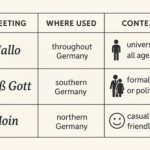
In most cultures, greetings are just polite sounds you make before getting to the real conversation. But in Germany, a greeting can do far more than say “hello.” It can mark your region, hint at your upbringing, signal your age, suggest your social class, and even forecast how formal or informal you intend to be. Germans may not always be talkative, but they’re highly attuned to how someone speaks – and that starts with the greeting.
This article explores what your choice of German greeting reveals about you, and why it matters more than most foreigners expect. Whether you’re meeting a stranger or reconnecting with someone you see daily, your first word carries weight.
A Culture Where Words Reflect Structure
German culture values structure, formality, and order – and the language reflects that. In daily interaction, a greeting isn’t just a social cue; it’s a coded message about your relationship to the person you’re addressing.
Greeting someone with Hallo, Guten Tag, Servus, or Na? might all be translated as “hello,” but they don’t mean the same thing socially. Germans notice the difference, consciously or not – and they use it to form immediate impressions.
What Greetings Signal About Regional Identity
If you say Moin, most people will assume you’re from Northern Germany. Grüß Gott? You’re probably Bavarian or Austrian – or at least trying to fit in. In a country where regional pride runs deep, your greeting often locates you geographically.
| Greeting | Region | Cultural Message |
|---|---|---|
| Grüß Gott | Bavaria, Austria | Traditional, rural, Catholic roots |
| Moin | Northern Germany | Down-to-earth, reserved, efficient |
| Servus | South Germany, Austria | Friendly, informal, local |
| Tach | Western Germany | Working-class, humorous |
| Na? | East/Central Germany | Urban, relaxed, minimalist |
If you’re traveling or moving within Germany, adjusting your greeting can show social awareness and willingness to adapt. Use the wrong one, and you may still be understood – but not fully welcomed.
To explore each region’s style in detail, start here:
➡️ Saying Hello in Germany: The Rules of Grüß Gott, Moin, and Hallo
Social Class, Education, and the Language of Politeness
Greetings in Germany can also hint at class, background, and even education level.
For example:
- Guten Tag and Guten Abend are considered more neutral and formal – often used in professional or middle-class environments.
- Hi and Hey are more casual and associated with younger or more informal circles.
- Na? may come across as overly familiar or sloppy in more formal settings – but perfectly normal among peers.
In short: greetings help Germans “read” each other. And if you want to make a good first impression, it pays to know what you’re signaling.
Age and Generational Language
Younger Germans are more relaxed with language and formality. You’re more likely to hear:
- Hi or Hey among teenagers and students
- Na? in messages, voice notes, or casual hangouts
- Moinsen or Hallöchen in memes, online chats, or joking tones
Older generations – particularly those over 60 – tend to prefer:
- Guten Tag
- Grüß Gott (in the South)
- Guten Morgen / Guten Abend in structured daily settings
Using the “wrong” greeting for someone’s age bracket can subtly influence how respectful, modern, or even socially competent you seem.
Greeting Hierarchy in the Workplace
In professional environments, greetings are especially loaded. If you’re a newcomer or intern greeting the company director, Guten Tag or Guten Morgen are safest. As relationships become more casual, you may be invited to use Hallo – or to switch to du (informal “you”).
Some subtle workplace greeting signals:
- A manager saying Hallo instead of Guten Tag may be signaling openness or a flat hierarchy.
- Coworkers saying Na? to each other suggests strong informal bonds.
- Using Hi or Hey too early might be seen as presumptuous.
Need help navigating formality? Read:
➡️ Hallo, Guten Tag, or Hi? When to Use Formal and Informal German Greetings
First Impressions and Greeting Faux Pas
A greeting is your first test in German interpersonal communication. Small missteps are forgiven – especially if you’re clearly a foreigner – but they do set the tone.
Common faux pas include:
- Using Hi in formal settings
- Greeting older people or strangers too casually
- Starting a conversation without any greeting (especially in shops or shared spaces)
- Using regional greetings in the wrong location (e.g. Grüß Gott in Hamburg)
Even minor mismatches can make you sound tone-deaf, awkward, or – worse – arrogant.
Code-Switching: How Germans Adapt Their Greetings
Germans often adjust their greetings based on who they’re talking to. A person might say Moin to their neighbor, Guten Tag to a client, and Hi to a friend – all in the same hour. This is code-switching, and it’s a common, socially intelligent behavior in Germany.
Want to sound native? Start listening to how Germans shift their greetings depending on:
- Setting (street vs office)
- Age (youth vs senior)
- Relationship (stranger vs close friend)
- Power dynamic (employee vs manager)
How Greetings Shape Belonging
Because greetings are immediate, subtle, and universal, they’re also deeply tied to the feeling of belonging. Adopting local greetings shows that you’re not just passing through – you’re participating in the culture.
Saying Moin in Kiel tells people you know where you are. Saying Servus in Vienna is a nod to shared experience. Saying Guten Tag in a new job shows professionalism. These tiny choices build social bridges.
To dive into each greeting in context, read:
➡️ Grüß Gott! Why Southern Germany Greets Like It’s Still Sunday
➡️ Moin! The Northern German Greeting That Works Any Time of Day
Key Takeaways
- Your German greeting instantly signals identity, region, and formality.
- Locals interpret greetings as social cues, even unconsciously.
- Matching your greeting to the context builds trust and credibility.
- Greetings vary by age, class, profession, and region.
- Adapting your greeting is a quiet but powerful way to belong.
The Small Word That Says So Much
In Germany, how you say hello may be a small act – but it carries enormous meaning. With just one word, you’re placing yourself on the cultural map: north or south, formal or informal, stranger or insider. By paying attention to greetings, you show not only that you’ve learned the language – but that you understand the culture.
Ready to greet Germans on their own terms? Return to the full guide:
➡️ Saying Hello in Germany: The Rules of Grüß Gott, Moin, and Hallo







